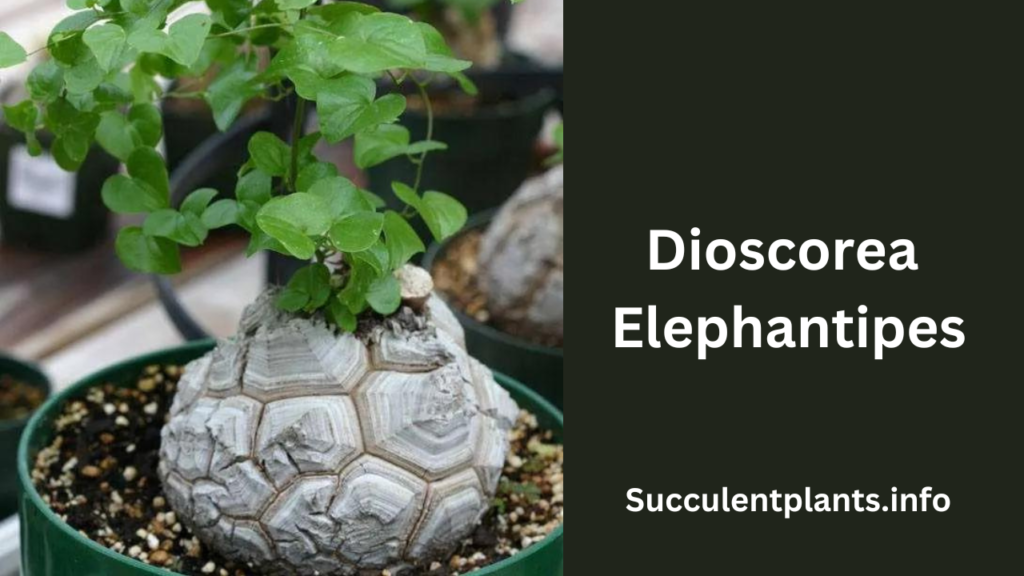
The nomenclature “Elephant’s Foot Vine” sparks curiosity about this botanical entity, known scientifically as Dioscorea Elephantipes. In botanical taxonomy, the lineage traces back to the Asparagaceae family, dwelling within the Dioscorea genus.
Botanical Lineage:
| Family | Genus | Scientific Name | Aliases |
|---|---|---|---|
| Asparagaceae | Dioscorea | Dioscorea Elephantipes | Elephant’s Foot Succulent, Elephant’s Foot Vine |
Plant Characteristics:
| Growth Season | Optimal Temperature | Hardiness Zone | Maturity Statistics |
|---|---|---|---|
| Flourishing in winter and spring. | Thrives in elevated temperatures. | USDA Zone 10 & above. | Stands at approximately 3 feet in height, with a girth spanning about 10 feet. |
Dioscorea Elephantipes Plant Behavior:
| Dormancy | Toxicity |
|---|---|
| Experiences summer dormancy. | A cautionary note – toxic to both humans and pets due to saponins. Abstain from ingestion! |
Dioscorea Elephantipes Unveiled: Curiosity piques as we delve into the enigma that is Dioscorea Elephantipes. Originating from the succulent spectrum within the Asparagaceae family, the nomenclature “Elephant Foot” stems from its stem’s uncanny resemblance to the creased contour of an elephant’s foot during its growth phase. Despite the initial impression of dormancy or impending demise, rest assured that the plant is robust and flourishing. This succulent hails from South Africa, often becoming a cherished heirloom passed down through generations.
Distinctive Features: Dioscorea Elephantipes boasts a distinctive attribute – a caudex mimicking the shape of an Elephant’s Foot. This characteristic defines its nomenclature and evolves as the plant matures, developing intricate ridges. Patience is key, as this species unfolds its magnificence over a gradual five-year growth span, attaining a pinnacle height of around 3 feet with an expansive diameter of 10 feet.
Cultivating Dioscorea Elephantipes:
Contrary to common assumptions about planting, succulents demand meticulous attention. Dioscorea Elephantipes, being no exception, necessitates strategic considerations for its prosperity.
- Selecting a Planting Locale: Opt for indoor germination for Dioscorea Elephantipes, subsequently transitioning outdoors if desired.
- Choosing an Apt Pot: The planting vessel should offer ample width for root expansion, negating the necessity for excessive depth.
- Employing Suitable Soil: Given the susceptibility of succulents to overhydration, employ well-draining potting soil. Consult with gardening experts for optimal soil brands.
- Illumination Prerequisites: Lighting prerequisites fluctuate between indoor and outdoor cultivation. Maintain a balance, ensuring adequate sunlight exposure without detriment.
Dioscorea Elephantipes Custodianship:
Navigating the labyrinth of plant care instructions can be daunting, but fret not, as Elephant Foot plant stewardship guidelines are concise and manageable.
- Utilize exclusively well-draining soil.
- Select plant pots featuring drainage apertures.
- Exercise restraint in watering to avert root decay and desiccation.
- Schedule watering sessions approximately once weekly, adjusting based on signs of desiccation.
- Mitigate extreme temperature exposure, balancing sunlight accessibility for leaves and stems.
- Position potted Dioscorea Elephantipes in well-lit, indirectly sunlit locations.
- Refrain from fertilization during dormancy or cold periods.
- Uphold a soil moisture level on the lighter side.
- Administer fertilizers sparingly, limited to a monthly schedule.
Procreation
For those ready to propagate Dioscorea Elephantipes, familiarity with adept techniques is indispensable. Two principal methods, seedling and trimming propagation, ensure safety and viability.
Seedling Propagation
Caution: This method necessitates Dioscorea Elephantipes seeds, obtainable online or by careful extraction from the parent plant.
- Procure viable seedlings, cleansing them gently and allowing them to air-dry.
- Employ appropriate soil and pots to plant seedlings, burying them at least one-third into the soil.
- Initiate watering and position the pot in a conducive environment.
- Maintain a weekly watering regimen for the gestation of new Dioscorea Elephantipes.
Trimming Propagation
Note: This technique, involving trimming sections of the parent plant’s stems, demands meticulous execution.
- Sanitize gardening shears thoroughly.
- Select a healthy, well-grown stem for trimming, ensuring cleanliness and subsequent air-drying.
- Plant trimmed stems in suitable soil, initiating a watering routine.
Further Insights
- Dormancy is a seasonal norm for Dioscorea elephantipes, primarily transpiring in May and June, requiring reduced watering.
- Dioecious in nature, manifesting both male and female plants through distinctive blooming flowers.
- A remarkable lifespan of up to 70 years is attainable with meticulous care, albeit contingent on optimal conditions. Overhydration stands as the primary threat to longevity.
- Toxicity looms if ingested, courtesy of saponins. Ensure a secure placement to obviate potential hazards.
In Summation: Dioscorea Elephantipes emerges as a visually striking botanical marvel, seamlessly integrating into both indoor and outdoor settings. Its uncomplicated maintenance and straightforward propagation processes make it an alluring addition. May this discourse provide comprehensive insights for nurturing flourishing Dioscorea Elephantipes.